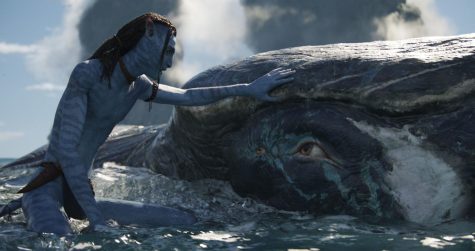‘Avatar: The Way of Water’: Stylish, but not substantial
January 16, 2023
Spoilers included in this review
Blues and greens dance across the screen in a scene of a planet similar, but not quite identical to that of Earth’s. The camera shifts to the side and pans in on a face and chest, just humanoid enough to be beautiful. Right from the first few scenes, “Avatar: The Way of Water,” directed by James Cameron, is a stunning piece of cinematography.
If a picture is a thousand words, then each frame of “Avatar: The Way of Water” alone deserves 10,000. Cameron’s beloved Pandora is a living, breathing, breathtaking world. It’s vision of a planet where there is no humanity to desecrate nature, one where the line between flora and fauna is whimsically blurred.
The plot is nothing special. Jake Sully and his family flee to a scattered bunch of islands on the ocean to escape the humans hunting them. They slowly assimilate into the native reef Na’vi population, where they endure bullying and learn to live as one of the reef Na’vi along the way. Spider, a human boy who was very close to the family before he was seized by humans, internally struggles over helping said humans even as they show immeasurable cruelty in their hunt of Jake.

When the Sully children are captured by the humans, Jake, his wife and their new reef friends fight to save them.
The characters of the film are similarly unremarkable. The main cast all have well-done arcs and visibly change throughout the film, but none are particularly unique or otherwise memorable. Each member of the Sully family is an example of a tried-and-true trope: the cowardly father who wrongly chooses flight over fight, the brave warrior mother who carries on her father’s legacy, the disappointing younger son jealous of his older brother, the moody adolescent daughter with a secret affinity for nature, the heroic older son who dies in the third act and the cute little girl who needs to be rescued. Perhaps the characters were intentionally written to be unoriginal to make the Na’vi’s experiences feel more familiar and close to home, but they all feel bland as a result.
There are twists and turns throughout the plot, but for the most part, they have little impact or are fairly predictable. Though the characters in the film may stumble and doubt themselves, the audience is sure that from beginning to end, good will prevail and the Sully family will come out on top. This predictability removes much of the tension that would otherwise have been felt when, for example, the Sully kids are first captured.
The film attempts to struggle with darker, more complex themes but they are painted in such a black-and-white way that they almost become simple. Na’vi is good and human is bad, with the exception of Spider and a few sympathetic extras. The film displays its anti-imperialism and pro-environment themes by making the invading humans comically villainous and entirely unsympathetic. It gets the point across but seems almost childish.
The movie’s runtime, an entire three hours and 12 minutes, is longer than needed for such a straightforward story. The plot feels artificially stretched with melodrama and many of the scenes are just unnecessary. The fight scenes drag the movie even longer and are rather violent for a PG-13 film. A two-hour runtime would perhaps have better conveyed all of Cameron’s themes and messages surrounding family and fear without being overly greedy of the audience’s time.
Overall, “Avatar: The Way of Water” is an acceptable story with acceptable characters. Despite all of its flaws, the fact remains that the film is ultimately a technical masterpiece and an entirely unique visual experience excelling at immersing you in a wonderful world.
“Avatar: The Way of Water”
3 hours, 12 minutes.
Rated PG-13.
Directed by James Cameron.




![In the fourth period AP Calculus BC class at Palo Alto High School, senior Crystal Li places her phone in the “phone jail.” Starting July 2026, this may become a normal procedure across schools in California thanks to Governor Gavin Newsom signing the Phone-Free School Act into law last week. According to Li, there are often unnecessary complications that come with enforcing phone restrictions. "It becomes a hassle putting it [a phone] in [the phone jail] before class, and taking it out after class," Li said. "There have been multiple times where kids from other periods interrupt the teacher to come back in and pick up a phone they left."](https://palyvoice.com/wp-content/uploads/2024/09/IMG_7386-3-300x225.jpg)



